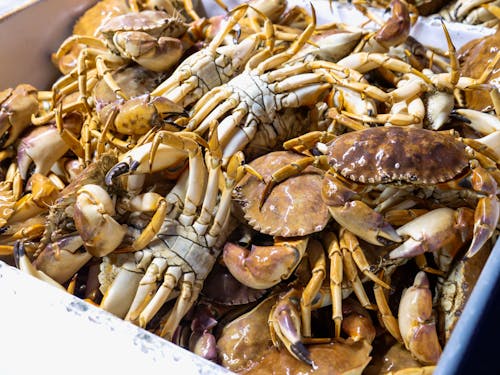A Full Guide to Catching Dungeness Crabs in the Tillamook Bay
There’s nothing like eating fresh Dungeness crabs that were well-cooked by you or any other chef. But maybe one thing does trump it, and that’s the feeling of catching and cooking your own crabs! There are a ton of opportunities to catch Dungeness crabs in Tillamook Bay, and if you’re up for it, you have the chance to go crabbing in the area.
Don’t worry – whether you’re a first-timer or a seasoned angler, anyone can go crabbing. You can head to Tillamook Bay with family and friends in hopes of a successful catch. But understandably, it can feel a bit daunting, especially if you have never gone crabbing before.
Read on as we share a guide on catching Dungeness crabs in Tillamook Bay.

How to Catch Dungeness Crabs in the Tillamook Bay
Tillamook Bay is the northern Oregon coast’s largest bay, a popular fishing destination for Chinook salmon and sturgeon. It also offers awesome crabbing opportunities, with five rivers pouring into it. When we mean big, we mean that Tillamook Bay is massive and has almost 600 acres of waterland!
When to Go Crabbing
Crabbing is legal all year-round on the Oregon coast, being open on beaches, bays, piers, tide pools, and jetties. Note that crabbing for Dungeness crabs in the ocean is closed every October 16 to November 30.
That said, it doesn’t mean that you can go anytime and always expect a successful day. The best times to crab are between September to November, though you can also try crabbing during late summer to early winter. Fall is the best as you get more filled-out crabs with quality meat. Any other time, it would be difficult to find crabs large enough to keep and enjoy.
During the summer, you might find underdeveloped or soft-shelled crabs, which we recommend releasing. These crabs would only have about 10-12% quality meat as opposed to those with hard shells, which have 20%.
Make sure that you plan your crabbing trip wisely. The best time of the day to go crab hunting is during the “slack” water times, either the peak high or low tide. Ready your bait and crab pots, along with well-marked buoys so you can easily identify which pots you own after casting the lines. Also, if it’s been raining a lot, the weather would affect the salinity in common crabbing areas. That’s a good thing as crabs love salty water, so you can have more chances crabbing in the ocean.
Dungeness crabs would usually move between Oregon’s bays and oceans, so the tide is a major factor in their movement. Crabs prefer calmer waters as they have fewer currents to fight during high and low tide, making it easier for foraging.

Rules and Regulations
The state requires a shellfish license, which is different from an angling license. The license is required if you plan to harvest crabs and clams, among other shellfish. You can avail of a license in most fishing or crabbing businesses, and it will be good for a year.
As for the crabbing limits, it would be 12 males at least 5 ¾ inches across the back. You should measure in front of the spines, which are the two spikes on the crab’s sides. As for red rock crabs, the second most popular crab on the Oregon coast, you can catch 24 of any gender or size daily.
Stay updated with the current shellfish regulations and harvest notices before heading out for a day of crabbing. The Oregon Department of Fish and Wildlife would update its website for any announcements or changes in rules and regulations.
Extra Tips
Generally, boat crabbing would reap a higher yield, though dockside crabbing is an easier and more accessible solution. You may harvest crabs directly from docks at the marinas, such as in Netarts Bay Marina, Wheeler Marina, or the Garibaldi Marina.
If you’re confused about where to go crabbing in Tillamook Bay, you can refer to this map for help. It shows where you can go crabbing and clamming, with some areas accessible by bank or walk-in. However, it’s best to reach certain areas by boat, which you can rent to navigate yourself or join a charter for crabbing.
You can find numerous supplies and boating facilities in Garibaldi, and most of the crabbing spots are located on the west of the port near jetties, on either side of the channel.
You can also consider going to “Crab Harbor,” which is located behind Kincheloe Point and across the main channel from Painted Rocks. Both Crab Harbor and the channel are accessible by boat but you can go to the public crabbing dock if you plan to catch crabs in Garibaldi.
Secure your bait to the gear and make sure you’re wearing gloves while doing so to avoid rope burn. You can opt for fresh or slightly rotten meat, which works as excellent bait as crabs have a good sense of smell with pungent foods piquing interest. Tie the end of the line to the dock then toss the crab pot in the water. Wait patiently and you can bring home a few crabs!
Once you catch your crabs, store them in ice packs, a bucket of water, or a cooler with ice. You can either take them home with you or have them cooked by nearby local restaurants.

Wrapping It Up
Do you know what tastes better than fresh Dungeness crabs? It’s fresh Dungeness crabs that you just caught yourself! If you already went crabbing, then you can fry that baby up in butter or toss it onto a salad with crisp produce, enjoying what you got from a memorable day in Tillamook Bay.
For those who haven’t gone crabbing yet but want to, contact us now! We can help you with your fishing charter and crabbing needs.
